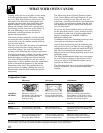
• Plastic cookware—Plastic cookware designed
for microwave cooking is very useful, but
should be used carefully. Even microwave-safe
plastic may not be as tolerant of overcooking
conditions as are glass or ceramic materials,
and may soften or char if subjected to short
periods of overcooking. In longer exposures
to overcooking, the food and cookware
could ignite.
• For these reasons:
• 1) Use microwave-safe plastics only and use
them in strict compliance with the cookware
manufacturer’s recommendations.
• 2) Do not subject empty cookware to
microwaving.
• 3) Do not permit children to use plastic
cookware without complete supervision.
• Cook meat and poultry thoroughly—meat to
at least an INTERNAL 160°F and poultry to
at least an INTERNAL 180°F. Cooking to these
temperatures usually protects against foodborne
illness.
SAFETY FACT—Superheated water.
Liquids, such as water, coffee or tea, are
able to be overheated beyond the boiling
point without appearing to be boiling.
Visible bubbling or boiling when the
container is removed from the microwave
oven is not always present. THIS COULD
RESULT IN VERY HOT LIQUIDS
SUDDENLY BOILING OVER WHEN
THE CONTAINER IS DISTURBED OR
A SPOON OR OTHER UTENSIL IS
INSERTED INTO THE LIQUID.
To reduce the risk of injury to persons:
— Do not overheat the liquid.
— Stir the liquid both before and halfway
through heating it.
— Do not use straight-sided containers with
narrow necks.
— After heating, allow the container to stand
in the microwave oven for a short time
before removing the container.
— Use extreme care when inserting a spoon
or other utensil into the container.
• Do not boil eggs in a microwave
/
convection
oven. Pressure will build up inside egg yolk
and will cause it to burst, possibly resulting
in injury.
• Foods with unbroken outer ‘‘skin’’
such as potatoes, sausages, tomatoes,
apples, chicken livers and other
giblets, and egg yolks (see previous
caution) should be pierced to allow
steam to escape during cooking.
• Not all plastic wrap is suitable for use in
microwave
/
convection ovens. Check the
package for proper use.
• ‘‘Boilable’’ cooking pouches and tightly closed
plastic bags should be slit, pierced or vented as
directed by package. If they are not, plastic could
burst during or immediately after cooking,
possibly resulting in injury. Also, plastic storage
containers should be at least partially uncovered
because they form a tight seal. When cooking
with containers tightly covered with plastic
wrap, remove covering carefully and direct
steam away from hands and face.
• Hot foods and steam can cause
burns. Be careful when opening
any containers of hot food,
including popcorn bags, cooking
pouches and boxes. To prevent
possible injury, direct steam away
from hands and face.
• Use of the shelf accessory.
— Use pot holders when handling the shelf and
cookware. They will be hot.
— Never use the shelf for microwave-only
cooking. Remove the shelf from the oven
when microwave-only cooking.
— Always place the shelf on the floor of the
oven for convection and combination
cooking.
SAVE THESE
INSTRUCTIONS
Important Safety Instructions
5


















